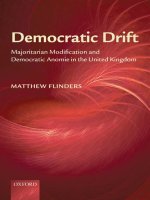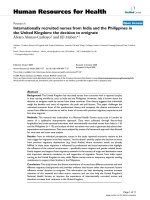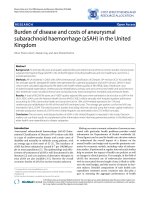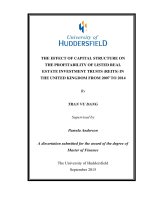English in Four Countries in the United Kingdom Thuyết trình môn Đa dạng Tiếng Anh
Bạn đang xem bản rút gọn của tài liệu. Xem và tải ngay bản đầy đủ của tài liệu tại đây (1.21 MB, 19 trang )
English in Four
Countries in the
United Kingdom
GROUP MEMBERS:
1.
2.
3.
4.
5.
Hồ Nguyễn Yến Nhi - 187NA00459
Đoàn Thị Hoàng Yến - 187NA10440
Nguyễn Ngọc Thanh Tuyền - 187NA23650
Nguyễn Hồng Sơn - 187NA11221
Phạm Trần Đông Phương – 187NA00550
Four Countries in the United
Kingdom
01
02
England
Scotland
03
04
Wales
Northern
Ireland
01
ENGLAND
The English language spoken and written in England encompasses a diverse range
of accents and dialects. The dialect forms part of the broader British English,
along with other varieties in the United Kingdom. Terms used to refer to the
English language spoken and written in England include: English English and
Anglo-English.
Basically there are three dialect areas, the
north, the midlands (east and west) and the
south (south west and south east) which are
already recognisable in the Old English
period. The subdivisions have shifted
somewhat but the tripartite division of
England has remained.
Phonology:
In England, northern and southern accents are clearly
distinguished by the pronunciation of the STRUT vowel,
which in the north is identical with FOOT.
The phonemic inventory was increased to six distinctive
short vowels instead of five. Unsplit FOOT-STRUT 'has to
be, along with the vowel in BATH, one of the most salient,
one of the most symbolic markers of Northern English
pronunciations today.
The high awareness of unsplit FOOT-STRUT has resulted in intermediate
forms, such as [kəp] for cup, and also in hypercorrect realisations of FOOT:
Ex: [‘ʃʊgə] for sugar.
H dropping, which is quite a natural phenomenon owing to the 'elusive'
character of [h] and known from varieties of many languages, is particularly
well known from traditional Cockney.
Lexicon :
Traditional Cockney was known to have many Yiddish loanwords, such as nosh for eat,
and, in particular, to make use of so-called ‘rhyming slang’, in which a two-term phrase
is used for a single everyday word with which it rhymes: trouble and strife for wife,
apples and pears for stairs. The second element in the phrase may be dropped: butcher’s
for look (from butcher’s hook), so ‘take a butcher’s’, loaf for head (from loaf of bread).
02
SCOTLAND
English is the main language spoken in
Scotland today and has been the since the
18th Century. However, there are a wide
range of different accents and dialects
spoken across the country. From the largest
cities right through to the smallest of our
islands, differing accents can be found.
These range from soft and sing-song to
stronger and more pronounced.
1. English in Scotland
- Scottish English refers to the varieties of English spoken in Scotland.
- The formal variety is called Standard Scottish English, SSE
- From 1707, the official written language of Scotland were Standard English has been used as
the language of religion, education and government and so it became the socially prestigious
form adopted by the aspiring middle classes.
- Standard English continued to be spoken with a variety of local accents.
- RP – the regionally non-specific accent of the upper middle classes in England – has a
negligible presence in Scotland.
-The variety of speech we might recognise as educated Scottish English contains the occasional
word – outwith for ‘outside’ – or grammatical structure – I’ve not heard for ‘I haven’t heard’ –
that is distinctively Scottish.
- Scottish English is recognisable by its pronunciation: speakers do not make the same
distinctions in vowel length made by speakers with other English accents and the vast majority
of speakers in Scotland are rhotic – that is, they pronounce the <r> sound after a vowel in words
like farm, first and better.
2.Scodialect
- Beside Standard Scottish English, the local vernacular language, Scots, a
dialect descended from Old English and closely related to Northumbrian
dialects has maintained a strong presence, especially in rural communities.
- Heated debate among linguists for many years as to whether Scots
constitutes a dialect or a distinct language in its own right.
- Officially classified as a ‘traditional language’ by the Scottish Executive.
- Whatever its status – language or dialect – large numbers of speakers would
certainly claim to speak Scots, not English.
03
WALES
-For the majority of people living in Wales, English is their first and only language.But
there are still areas where Welsh being the everyday means of communication.
-Many speakers were and are bilingual in English and Welsh, and because the two
languages have existed side-by-side within the same communities for generations->
Welsh has also exerted a strong influence on the English spoken in Wales.
-Some regions became English-speaking many centuries ago, while in others (such as the
South Wales Valleys) English has taken over comparatively recently.
-A couple of centuries ago, Welsh was the language of most of Wales, apart from a few
Englishries such as South Pembrokeshire and the Gower peninsula and in some parts of
Herefordshire at one time.
-In some Welsh accents of English, you can hear the influence of neighbouring English
counties, such as Cornwall or Herefordshire.
• Some phonetic aspects of Welsh English are:
- Opening and lengthening of vowels .The vowels are
generally more open and elongated than in other
variants of English.
- The –i is pronounced like the schwa in words like
kit, pit, and going.For example, going is pronounced
/go-ǝn/.
- Most consonants, such as “h” and “f”, are dragged
out while others are dropped.For example, Can I have
some of that? becomes Can I ave some ov that?
04
Northern
Ireland
Northern Ireland is described as a
country, province or region of
England. Northern Ireland borders the
Republic of Ireland to the south and
west.
According to the 2011 census, there are
1,810,900 residents in Northern Ireland, about
30% of the total population of the island of
Ireland and about 3% of the population of
Great Britain.
• Irish Gaelic language is spoken as a first language by a small minority of
Irish people, and as the second language by a larger group of non-native
speakers.
• English is the first language of nearly the entire population of Northern Ireland.
English is the de facto official language and the Administration of Justice
(Language) Act (Ireland) 1737 prohibits the use of languages other than English in
legal proceedings.
• Irish has been the primary language of the Irish people throughout
their history.
• They brought the language to many countries, most notably Scotland
and the Isle of Man.
• Through an earlier form of Irish, Middle Irish, the basis of which
Scottish Gaelic and Manchu were born. Ireland possesses the oldest
vernacular literature in Western Europe.
THANKS FOR YOUR
LISTENING !









